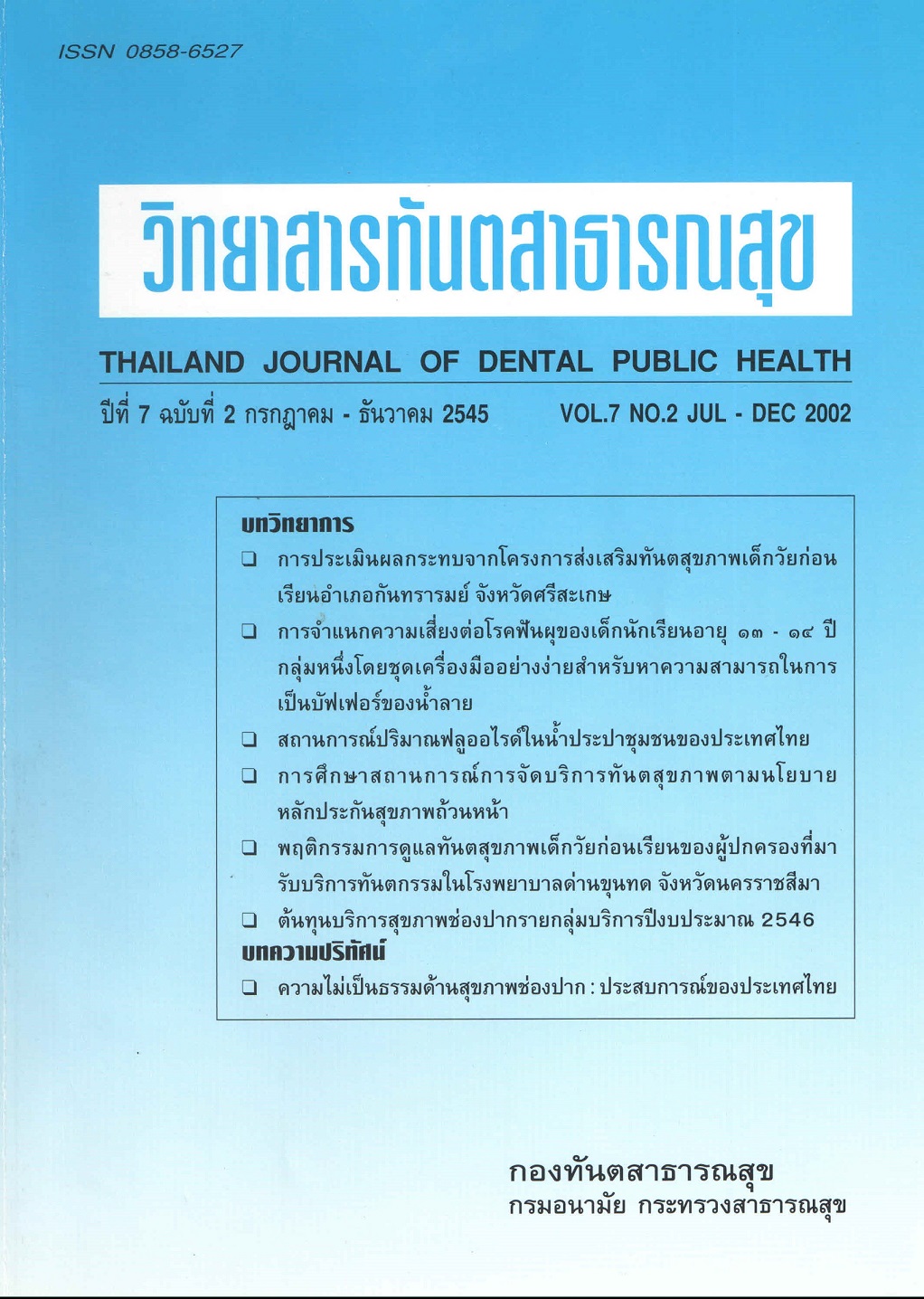Oral Health Care Behaviors of Pre-school children parents who received dental treatment in Dan Kun Thot Hospital. Nakhon Ratchasima Province.
Main Article Content
Abstract
This research was designed as a descriptive study. The purpose was to describe the oral health care behaviors of pre-school children parents. Sixty three parents of 3-6 years old children were obtained through a systematic random sampling. Data were gathered by semi-structured questionnaires during the period between December 2002 and January 2003. The results showed that the parents level of the knowledge, beliefs and attitudes towards oral health care behaviors in pre-school children were at the medium level and the percentages of those were 82.54%, 66.67% and 53.97% respectively. Pre-school children had the average number of decayed, missing and filling teeth of 6.73 teeth. Cleansing teeth and gum with a toothbrush were 88.89% and self teeth brushing was 80.36%. 61.91% of children had sweet candy and most of them (93.65%) did not brush their teeth after meal and 63.83% of those had fillings. Toothache (55.56%) was a major complaint to bring them for the dental treatments and most of them went to see the dentist at the public hospital as a convenient reason. 31.11% of oral health care information sources was bought to the parents by a dental health team and public health officers. For suggestion, as the knowledge, beliefs and attitudes of parents towards oral health care behaviors were medium, the parents should pay more practical behaviors with dental caries checking up, tooth brushing and avoid giving sweet candy for good oral health of their children.
Downloads
Article Details
References
2. กองทันตสาธารณสุข กรมอนามัย กระทรวงสาธารณสุข. รายงานผลการสํารวจสภาวะทันตสุขภาพแห่งชาติครั้งที่ 4พ.ศ.2537 ประเทศไทย. กรุงเทพฯ: โรงพิมพ์องค์กรสงเคราะห์ทหารผ่านศึก. 2537
3. กองทันตสาธารณสุข กรมอนามัย กระทรวงสาธารณสุข. กุญแจสู่ความสําเร็จของงานส่งเสริมสุขภาพช่องปาก. ออล ริ้นซ้อพ. 2545.
4. วสุ เทียนกิ่งแก้ว โรคฟันผุที่เกิดจากพฤติกรรมการเลี้ยงดูในเด็กก่อนวัยเรียน วิทยาสารทันตสาธารณสุข ปีที่ 3 ฉบับที่ 1: 2541 ; 63-67.
5. ประภาพรรณ โภคะสุวรรณ. การประยุกต์แบบแผนความเชื่อด้านสุขภาพร่วมกับกระบวนการกลุ่มและการกระตุ้นเตือนต่อพฤติกรรมมารดาในการดูแลทันตสุขภาพเด็กก่อนวัยเรียน ภาคนิพนธ์หลักสูตรสาธารณสุขศาสตรบัณฑิต คณะสาธารณสุขศาสตร์ มหาวิทยาลัยมหิดล. 2543.
6. Tinanoff N., Palmer S.A. Dietary Determinants of Dental Caries and Dietary Recommendations for Preschool Children. J. Public Health Dent, Vol.60 No.2: 2000; 197-206.
7. อรุณ จิรวัฒน์กุล, ชีวสถิติ, ภาควิชาชีวสถิติและประชากรศาสตร์ คณะสาธารณสุขศาสตร์ มหาวิทยาลัยขอนแก่น. 2542.
8. ภิรมย์ กมลรัตนกุล, มนต์ชัย ชาลาประวรรตน์, ทวีสิน ตันประยูร. หลักการทําวิจัยให้สําเร็จ. พิมพ์ครั้งที่ 2. กรุงเทพฯ: เท็กซ์ แอนด์ เจอร์นัล พับลิเคชั่น จํากัด. 2543.
9. ทวีศักดิ์ พากเพียร และคณะ, ทันตกรรมป้องกัน, โครงการตําราวิทยาลัยการสาธารณสุขสิรินธรจังหวัดขอนแก่น กองฝึกอบรม, สํานักงานปลัดกระทรวงสาธารณสุข 2534
10. บุญเอื้อ ยงวานิชากร และคณะ. สถานการณ์การดูแลสุขภาพช่องปากและการใช้บริการทันตกรรมของประชาชน วิทยาสารทันตสาธารณสุข, ปีที่6 ฉบับที่ 2: 2544; 105-117.
11. จารุวรรณ ตันกุรานนท์, ปิยวัฒน์ พันธุ์โกศล. ความสัมพันธ์ระหว่างสภาวะฟันผุกับการบริโภคและการดูแลอนามัยในช่องปากของนักเรียนประถมศึกษาปีที่ 6 ในโรงเรียนสังกัดกรุงเทพมหานคร. วารสารทันตแพทย์ศาสตร์จุฬาลงกรณ์มหาวิทยาลัย, ปีที่19 ฉบับที่ 2: 2539; 103-113.
12. ยลฉลวย วารินสวัสดิ์ และคณะ, การศึกษาอิทธิพล ทางสังคม และเศรษฐกิจที่มีผลต่อการรับรู้ความเข้าใจและพฤติกรรมของประชาชนที่มารับบริการทันตกรรมในกรุงเทพมหานคร. เอกสารวิชาการหมายเลข 65 สถาบันวิจัยและสังคมมหาวิทยาลัยมหิดล. 2525.
13. น้ําเพชร ตั้งยิ่งยง, เพ็ญศรี สมชัย. การพัฒนาศักยภาพ อสม. ด้านทันตสุขภาพแบบชุมชนมีส่วนร่วมวิทยาสารทันตสาธารณสุข, ปีที่ 5 ฉบับที่ 2: 2543, 32-41.

